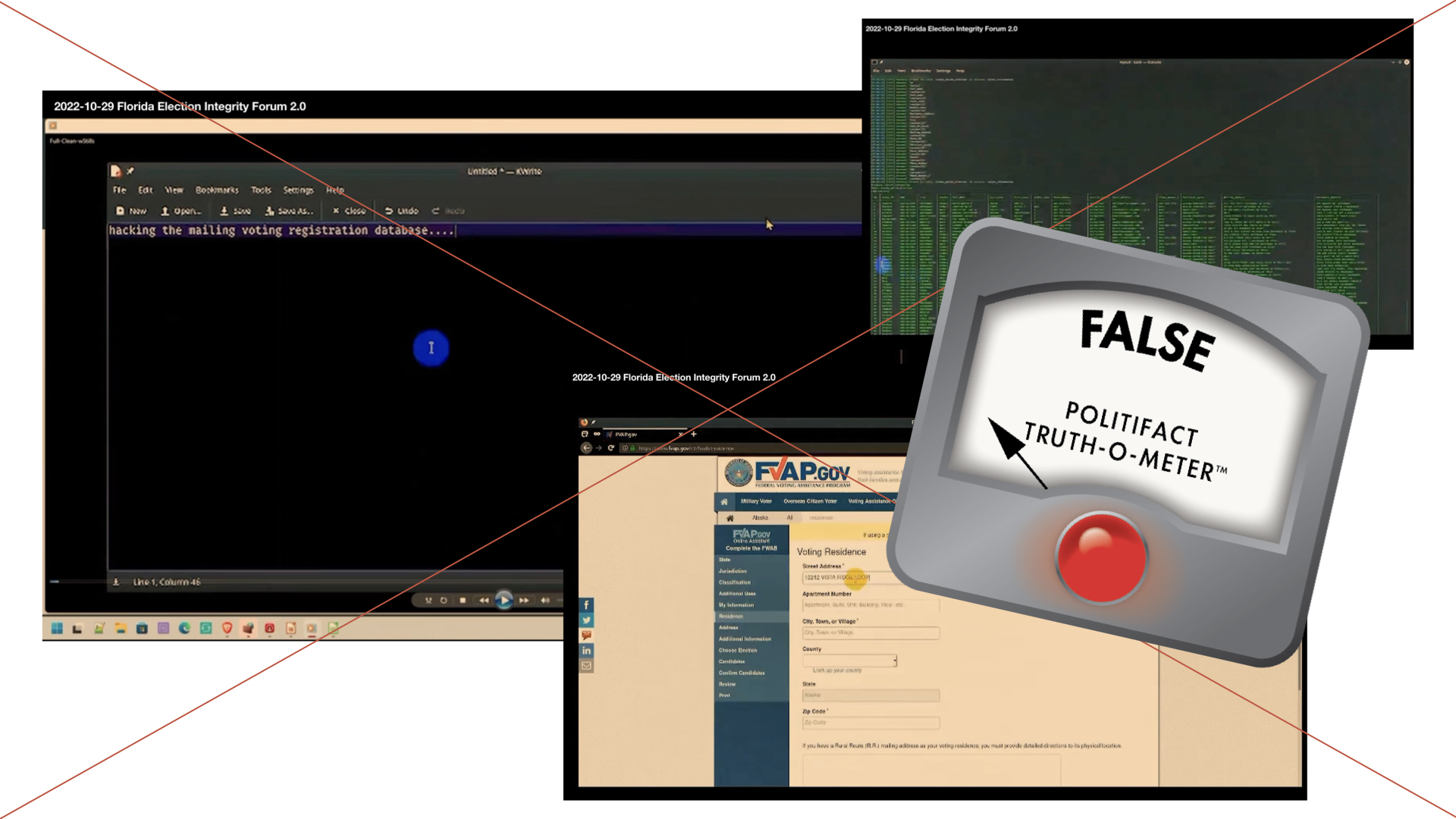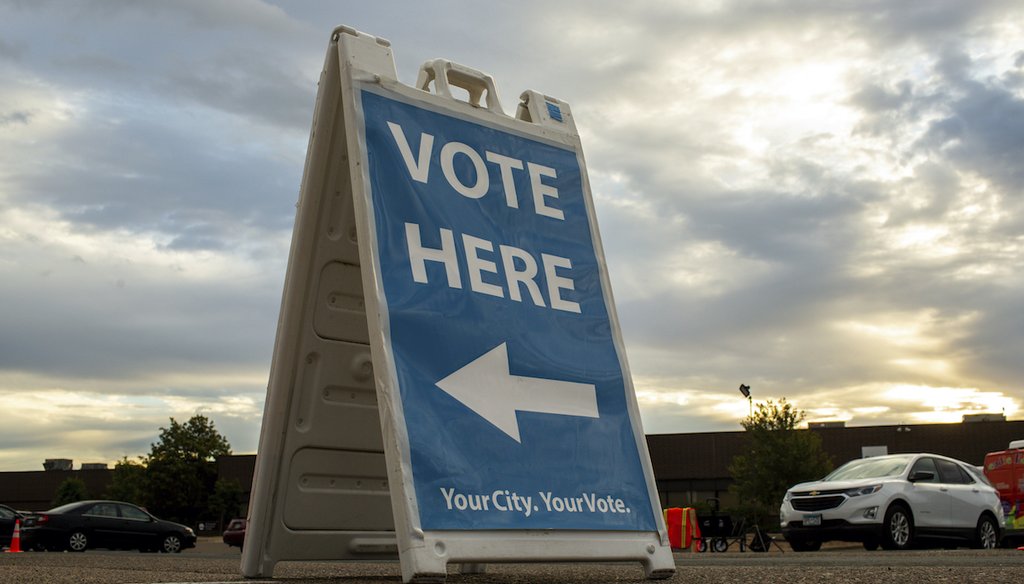



Voting signs direct voters to the Minneapolis Elections and Voter Services center on Friday, Sept. 23, 2022, in Minneapolis. (AP)
At an Oct. 29 event featuring well-known election deniers, a panelist played a video he claimed showed a whistleblower creating fraudulent military ballots. Video footage from the event circulated widely on social media before the Nov. 8 midterm elections.
The video the panelist showed features the same content as a video that was linked to a voter intimidation and influence campaign that took place from August to November 2020, a U.S. Attorney’s Office spokesperson said.
The 2020 video was a simulation and does not depict the fraudulent creation of real ballots, according to a 2021 indictment. The federal government charged two Iranian nationals who created the video with breaking federal laws related to voter intimidation.
At an Oct. 29 event featuring well-known election deniers, a panelist showed a video he framed as a distressing example of vulnerability in U.S. election infrastructure.
"This is an Iranian whistleblower," said Mark Cook, who introduced the video. "This just got dropped in my lap a couple days ago. But this is actually real."
Cook claimed the video showed a whistleblower creating fraudulent military ballots during the 2020 presidential election. He said the whistleblower used a tool that could be downloaded online to connect to an American voter registration database. Then, Cook said, the whistleblower extracted Alaskan voter registration data and used it to create "a military ballot."
"This is a video from their system and they did this, apparently, in the 2020 election," Cook said during a conference co-sponsored by the America First Secretary of State Coalition. The coalition is a QAnon-linked group of Republican election deniers who ran in 2022 to take control of elections offices in Nevada, Arizona, Michigan and other swing states.
Video footage from the event circulated widely on social media in the days before the Nov. 8 midterm elections, including in a Nov. 3 Instagram post.
The post was flagged as part of Instagram’s efforts to combat false news and misinformation on its News Feed. (Read more about our partnership with Meta, which owns Facebook and Instagram.)

This video, which was showed at an event featuring well-known election deniers, did not show the fraudulent creation of real ballots. (Screenshots from ACCFEI event recording)
When PolitiFact investigated the origin of the video Cook showed, we found that it does not show the fraudulent creation of real ballots. It was a simulation created during the 2020 presidential election as part of an effort to undermine voters’ confidence in the security of U.S. election infrastructure, federal officials said.
Federal officials discovered this effort, investigated it and charged two people involved in the conspiracy with crimes. U.S. Attorney Damian Williams for the Southern District of New York in 2021 described the video as "a fictitious video that purported to depict actors fabricating overseas ballots."
Nicholas Biase, a U.S. Attorney’s Office spokesperson, said the video Cook showed features the same content that was linked to a voter intimidation and influence campaign that took place from August to November 2020.
He said it substantially matches a video referred to in a 2021 indictment. The Justice Department said two Iranian nationals had created and circulated a "false election video" that depicted "an individual hacking into state voter websites and using stolen voter information to create fraudulent absentee ballots through the Federal Voting Assistance Program (FVAP) for military and overseas voters."
Federal investigators made it clear, though, that the video was not evidence that someone had created fraudulent ballots that were counted during the 2020 presidential election.
"The computer intrusions depicted in the False Election Video were simulated intrusions created by members of the conspiracy using their own server and data obtained" when the hackers successfully compromised one state’s voter registration website, the Justice Department said. "Further, the (Federal Voting Assistance Program) could not actually be leveraged in the manner implied by the False Election Video."
The people responsible were described as "experienced Iran-based computer hackers." The pair faced charges including one count of conspiracy to commit computer fraud and abuse, intimidate voters, and transmit interstate threats; one count of voter intimidation; and one count of transmission of interstate threats.
The U.S. Treasury Department in 2021 also announced it was imposing sanctions on six Iranians and one Iranian entity in connection with the attempt to influence the U.S. election in 2020.
A video shared on Instagram says it shows a whistleblower creating fraudulent military ballots during the 2020 presidential election.
The clip does not depict the fraudulent creation of real ballots.
A Justice Department official confirmed that the video features the same content as one linked to a 2020 voter intimidation and influence campaign. That video was a simulation, and the people who created it were charged with breaking several federal laws.
We rate the claim False.
PolitiFact researcher Caryn Baird contributed to this report.
RELATED: Election denying candidates sought to undo voting rights. Many lost key races
RELATED: A coalition of ‘stop the steal’ Republicans aims to take control of US elections. QAnon is helping
U.S. Department of Treasury, Treasury sanctions Iran cyber actors for attempting to influence the 2020 U.S. presidential election, Nov. 18, 2021
Cybersecurity & Infrastructure Security Agency, Election security rumor vs. reality, accessed Nov. 8, 2022
American Citizens & Candidates Forum for Election Integrity, Florida Election Integrity Conference 2.0, recorded Oct. 29, 2022
Instagram post, Nov. 3, 2022
Instagram post featuring cross-posted TikTok, Nov. 2, 2022
Tweet, Nov. 3, 2022
U.S. Department of Justice, Two Iranian nationals charged for cyber-enabled disinformation and threat campaign designed to influence the 2020 U.S. presidential election, Nov. 18, 2021
U.S. Department of Justice, United States v. Kazemi, 21 Cr. 644, accessed Nov. 8, 2022
Emailed statement from Nicholas Biase, spokesperson for the U.S. Attorney’s Office, Nov. 8, 2022
The Washington Post, U.S. indicts two Iranian hackers over 2020 election disinformation campaign, Nov. 18, 2021
Cybersecurity & Infrastructure Security Agency, Cyber threats to voting processes could slow but not prevent voting, Sept. 23, 2020
American Citizens & Candidates Forum for Election Integrity, Florida Election Integrity Conference 2.0 poster, accessed Nov. 9, 2022
PolitiFact, Jim Marchant, accessed Nov. 9, 2022
PolitiFact, Mark Finchem, accessed Nov. 9, 2022
PolitiFact, Michigan Republican secretary of state pick leveled baseless claims of election misconduct, May 6, 2022
The Associated Press, Iranian ‘hacking’ video fabricated to push election disinfo, Nov. 7, 2022
In a world of wild talk and fake news, help us stand up for the facts.
